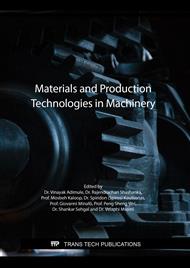[1]
V.I. Solomatov, Development of the Polystructural Theory of Composite Building Materials, J. University news. Construction and architecture. 8 (1985) 58-64.
Google Scholar
[2]
V.I. Solomatov, V.N. Vyrovoy, Physical Features of the Formation of the Structure of Composite Building Materials, J. University news. Construction and architecture. 8 (1984) 59-64.
Google Scholar
[3]
A.I. Ryazanov, A.D. Sukhanov, Synergetics, Moscow, (1984).
Google Scholar
[4]
G. Haken, Synergetics: Hierarchy of Instabilities in Self-forming Systems, Moscow, (1985).
Google Scholar
[5]
V.S. Dorofeev, V.N. Vyrovoy, V.I. Solomatov, Ways to Reduce the Material Consumption of Construction Materials and Structures, Kiev, (1989).
Google Scholar
[6]
S. Fic, M. Szeląg. Analysis of the Development of Cluster Cracks Caused by Elevated Temperatures in Cement Paste, J. Construction and Building Materials. 83 (2015) 223-229.
DOI: 10.1016/j.conbuildmat.2015.03.044
Google Scholar
[7]
N.V. Pushkar, Hаssein Juhad Salman Al-Amery, Sabir Yousif Bakir, Technological Damage of Concrete Reinforced by Polypropylene Fiber, J. University Annals – Constantza. Series: Civil Engineering (2013) 79-82.
Google Scholar
[8]
M. Szeląg. The Influence of Cement Composite Composition on the Geometry of their Thermal Cracks, Lublin, (2017).
Google Scholar
[9]
V.N. Vyrovoy, V.S. Dorofeev, S.S. Makarova, S.A. Abakumov, A Method for Detecting Cracks in Concrete and Reinforced Concrete Structures on an Inorganic Binder, Kiev, (1991).
Google Scholar
[10]
V.V. Bolotin, Mechanics of Composite Materials and Structures from Them, J. Structural mechanics. Current state and development prospects (1972) 65-98.
Google Scholar
[11]
T. Fudzii, M. Dzako, Fracture Mechanics of Composite Materials, Moscow, (1982).
Google Scholar
[12]
V. Dorofeev, H. Zinchenko, N. Pushkar, The Influence of Concrete Structure on the Destruction of Reinforced Concrete Bended Elements, Lecture Notes in Civil Engineering (2020) 103-111.
DOI: 10.1007/978-3-030-57340-9_13
Google Scholar
[13]
M. Szeląg, S. Fic, Analysis of the Development of Cluster Cracks in the Cement Paste Modified by Microsilica, J. Construction and architecture. 14 (2015) 117-127.
DOI: 10.35784/bud-arch.1552
Google Scholar
[14]
V. Ramachandran, R. Feldman, J. Boduen, Concrete Science, Moscow, (1986).
Google Scholar
[15]
V. Dorofeyev, I. Myronenko, N. Pushkar, Technological Damage to Concrete and Operation of Reinforced Concrete Structures, Collective monograph (2020) 165-184.
DOI: 10.30525/978-9934-588-86-0.09
Google Scholar
[16]
D. Barnat-Hunek, G. Lagod, S. Fic, M. Jarosz-Hadam, Effect of Polysiloxanes on Roughness and Durability of Basalt Fibres–Reinforced Cement Mortar, Lublin, (2018).
DOI: 10.3390/polym10040420
Google Scholar
[17]
S. Fic, N. Lyubomirskiy, D. Barnat-Hunek, The Influence of the Natural Aggregate Roughness on the ITZ Adhesion in Concrete, Switzerland, (2018).
DOI: 10.4028/www.scientific.net/msf.931.564
Google Scholar
[18]
V. Litvinenko, L.Dukre, Influence of the Composition of Concrete on the Technological Damage of Prefabricated Monolithic Structures, J. Current Scientific Research in the Modern World. 4 (2021) 114-119.
Google Scholar


